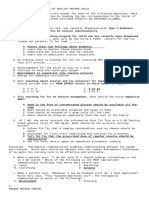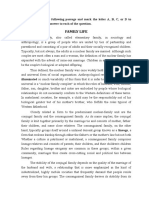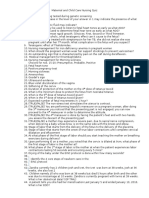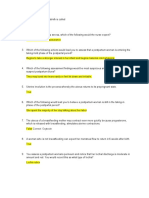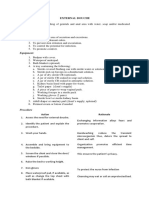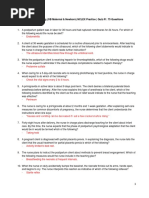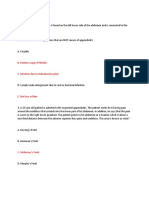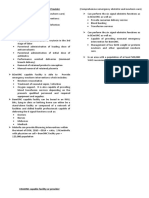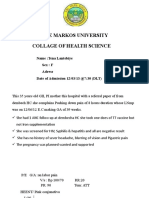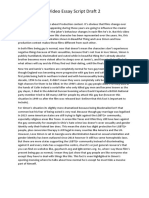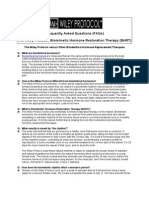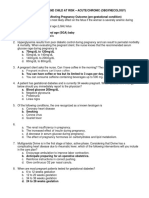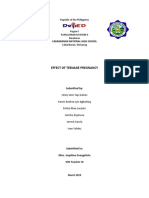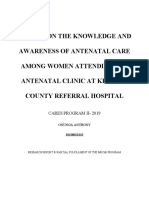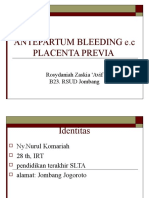Q1MCN - Nurseslabs
Q1MCN - Nurseslabs
Uploaded by
dhodejunlCopyright:
Available Formats
Q1MCN - Nurseslabs
Q1MCN - Nurseslabs
Uploaded by
dhodejunlOriginal Title
Copyright
Available Formats
Share this document
Did you find this document useful?
Is this content inappropriate?
Copyright:
Available Formats
Q1MCN - Nurseslabs
Q1MCN - Nurseslabs
Uploaded by
dhodejunlCopyright:
Available Formats
MCN – NURSESLABS C.
Taking hold
QUIZ 1 D. Resolution
1. A postpartum patient was in labor for 30 hours and had
ruptured membranes for 24 hours. For which of the 8. A pregnant client is diagnosed with partial placenta
following would the nurse be alert? previa. In explaining the diagnosis, the nurse tells the
client that the usual treatment for partial placenta previa is
which of the following?
A. Endometritis
B. Endometriosis
C. Salpingitis A. Activity limited to bed rest
D. Pelvic thrombophlebitis B. Platelet infusion
C. Immediate cesarean delivery
D. Labor induction with oxytocin
2. A client at 36 weeks gestation is scheduled for a routine
ultrasound prior to an amniocentesis. After teaching the
client about the purpose for the ultrasound, which of the 9. The nurse plans to instruct the postpartum client about
following client statements would indicate to the nurse in methods to prevent breast engorgement. Which of the
charge that the client needs further instruction? following measures would the nurse include in the
teaching plan?
A. The ultrasound will help to locate the placenta
B. The ultrasound identifies blood flow through the umbilical A. Feeding the neonate a maximum of 5 minutes per side on
cord the first day
C. The test will determine where to insert the needle B. Wearing a supportive brassiere with nipple shields
D. The ultrasound locates a pool of amniotic fluid C. Breast-feeding the neonate at frequent intervals
D. Decreasing fluid intake for the first 24 to 48 hours
3. While the postpartum client is receiving heparin
for thrombophlebitis, which of the following drugs would 10. When the nurse on duty accidentally bumps the
the nurse expect to administer if the client develops bassinet, the neonate throws out its arms, hands opened,
complications related to heparin therapy? and begins to cry. The nurse interprets this reaction as
indicative of which of the following reflexes?
A. Calcium gluconate
B. Protamine sulfate A. Startle reflex
C. Methylergonovine (Methergine) B. Babinski reflex
D. Nitrofurantoin (Macrodantin) C. Grasping reflex
D. Tonic neck reflex
4. When caring for a 3-day-old neonate who is receiving
phototherapy to treat jaundice, the nurse in charge would 11. A primigravida client at 25 weeks gestation visits the
expect to do which of the following? clinic and tells the nurse that her lower back aches when
she arrives home from work. The nurse should suggest
that the client perform:
A. Turn the neonate every 6 hours
B. Encourage the mother to discontinue breastfeeding
C. Notify the physician if the skin becomes bronze in color A. Tailor sitting
D. Check the vital signs every 2 to 4 hours B. Leg lifting
C. Shoulder circling
D. Squatting exercises
5. A primigravida in active labor is about 9 days post-term.
The client desires a bilateral pudendal
block anesthesia before delivery. After the nurse explains 12. Which of the following would the nurse in charge do
this type of anesthesia to the client, which of the following first after observing a 2-cm circle of bright red bleeding on
locations identified by the client as the area of relief would the diaper of a neonate who just had a circumcision?
indicate to the nurse that the teaching was effective?
A. Notify the neonate’s pediatrician immediately
A. Back B. Check the diaper and circumcision again in 30 minutes
B. Abdomen C. Secure the diaper tightly to apply pressure on the site
C. Fundus D. Apply gentle pressure to the site with a sterile gauze pad
D. Perineum
13. Which of the following would the nurse most likely
6. The nurse is caring for a primigravida at about 2 months expect to find when assessing a pregnant client with
and 1-week gestation. After explaining self-care measures abruption placenta?
for common discomforts of pregnancy, the nurse
determines that the client understands the instructions
when she says: A. Excessive vaginal bleeding
B. Rigid, board-like abdomen
C. Titanic uterine contractions
A. “Nausea and vomiting can be decreased if I eat a few D. Premature rupture of membranes
crackers before arising.”
A. High-pitched speech with tonal variations A. Proteinuria, headaches, vaginal bleeding
B. Low-pitched speech with a sameness of tone B. Headaches, double vision, vaginal bleeding
C. Cooing sounds rather than words C. Proteinuria, headaches, double vision
D. Repeated stimulation with loud sounds D. Proteinuria, double vision, uterine contractions
16. A 31-year-old multipara is admitted to the birthing 24. Because cervical effacement and dilation are not
room after initial examination reveals her cervix to be at 8 progressing in a patient in labor, the doctor orders I.V.
cm, completely effaced (100 %), and at 0 station. What administration of oxytocin (Pitocin). Why must the nurse
phase of labor is she in? monitor the patient’s fluid intake and output closely during
oxytocin administration?
A. Active phase
B. Latent phase A. Oxytocin causes water intoxication
C. Expulsive phase B. Oxytocin causes excessive thirst
D. Transitional phase C. Oxytocin is toxic to the kidneys
D. Oxytocin has a diuretic effect
17. A pregnant patient asks the nurse if she can take
castor oil for her constipation. How should the nurse 25. Five hours after birth, a neonate is transferred to the
respond? nursery, where the nurse intervenes to
prevent hypothermia. What is a common source of radiant
heat loss?
A. “Yes, it produces no adverse effect.”
B. “No, it can initiate premature uterine contractions.”
C. “No, it can promote sodium retention.” A. Low room humidity
D. “No, it can lead to increased absorption of fat-soluble B. Cold weight scale
vitamins.” C. Cool incubator walls
D. Cool room temperature
18. A patient in her 14th week of pregnancy has presented
with abdominal cramping and vaginal bleeding for the past 26. After administering bethanechol to a patient
8 hours. She has passed several clots. What is the with urine retention, the nurse in charge monitors the
primary nursing diagnosis for this patient? patient for adverse effects. Which is most likely to occur?
A. Knowledge deficit A. Decreased peristalsis
B. Fluid volume deficit B. Increase heart rate
C. Anticipatory grieving C. Dry mucous membranes
D. Pain D. Nausea and Vomiting
19. Immediately after delivery, the nurse-midwife assesses 27. The nurse in charge is caring for a patient who is in the
the neonate’s head for signs of molding. Which factors first stage of labor. What is the shortest but most difficult
determine the type of molding? part of this stage?
A. Fetal body flexion or extension A. Active phase
B. Maternal age, body frame, and weight B. Complete phase
C. Maternal and paternal ethnic backgrounds C. Latent phase
D. Maternal parity and gravidity D. Transitional phase
20. For a patient in active labor, the nurse-midwife plans to 28. After 3 days of breastfeeding, a postpartal patient
use an internal electronic fetal monitoring (EFM) device. reports nipple soreness. To relieve her discomfort, the
What must occur before the internal EFM can be applied? nurse should suggest that she:
A. The membranes must rupture A. Apply warm compresses to her nipples just before feedings
B. The fetus must be at 0 station B. Lubricate her nipples with expressed milk before feeding
C. The cervix must be dilated fully C. Dry her nipples with a soft towel after feedings
D. The patient must receive anesthesia D. Apply soap directly to her nipples, and then rinse
21. A primigravida patient is admitted to the labor delivery 29. The nurse is developing a teaching plan for a patient
area. Assessment reveals that she is in the early part of who is 8 weeks pregnant. The nurse should tell the patient
the first stage of labor. Her pain is likely to be most that she can expect to feel the fetus move at which time?
intense:
A. Between 10 and 12 weeks’ gestation
A. Around the pelvic girdle B. Between 16 and 20 weeks’ gestation
B. Around the pelvic girdle and in the upper arms C. Between 21 and 23 weeks’ gestation
C. Around the pelvic girdle and at the perineum D. Between 24 and 26 weeks’ gestation
D. At the perineum
Answers and Rationale nursing can be done conveniently to meet the neonate’s and
mother’s needs.
1. Answer: A. Endometritis
10. Answer: A. Startle reflex
Endometritis is an infection of the uterine lining and can occur
after prolonged rupture of membranes. The Moro, or startle, reflex occurs when the neonate responds
to stimuli by extending the arms, hands open, and then moving
the arms in an embracing motion. The Moro reflex, present at
• Option A: Endometriosis does not occur after a birth, disappears at about age 3 months.
strong labor and prolonged rupture of
membranes.
11. Answer: A. Tailor sitting
• Option B: Salpingitis is a tubal infection and could
occur if endometritis is not treated.
• Option C: Pelvic thrombophlebitis involves a clot Tailor sitting is an excellent exercise that helps to strengthen
formation, but it is not a complication of prolonged the client’s back muscles and also prepares the client for the
rupture of membranes. process of labor. The client should be encouraged to rest
periodically during the day and avoid standing or sitting in one
2. Answer: B. The ultrasound identifies blood flow through position for a long time.
the umbilical cord
12. Answer: D. Apply gentle pressure to the site with a
Before amniocentesis, a routine ultrasound is valuable in sterile gauze pad
locating the placenta, locating a pool of amniotic fluid, and
showing the physician where to insert the needle. Color
Doppler imaging ultrasonography identifies blood flow through If bleeding occurs after circumcision, the nurse should first
the umbilical cord. A routine ultrasound does not accomplish apply gently pressure on the area with sterile gauze. Bleeding
this. is not common but requires attention when it occurs.
3. Answer: B. Protamine sulfate 13. Answer: B. Rigid, board-like abdomen
Protamine sulfate is a heparin antagonist given intravenously The most common assessment finding in a client with
to counteract bleeding complications caused by heparin abruption placenta is a rigid or boardlike abdomen. Pain,
overdose. usually reported as a sharp stabbing sensation high in the
uterine fundus with the initial separation, also is common.
4. Answer: D. Check the vital signs every 2 to 4 hours
14. Answer: B. Notify the physician immediately
While caring for an infant receiving phototherapy for treatment
of jaundice, vital signs are checked every 2 to 4 hours The nurse should contact the physician immediately because
because hyperthermia can occur due to the phototherapy the client is most likely experiencing hypotonic uterine
lights. contractions. These contractions tend to be painful but
ineffective. The usual treatment is oxytocin augmentation
unless cephalopelvic disproportion exists.
5. Answer: D. Perineum
15. Answer: A. High-pitched speech with tonal variations
A bilateral pudendal block is used for vaginal deliveries to
relieve pain primarily in the perineum and vagina. Pudendal
block anesthesia is adequate for episiotomy and its repair. Providing stimulation and speaking to neonates is important.
Some authorities believe that speech is the most important
type of sensory stimulation for a neonate. Neonates respond
6. Answer: A. “Nausea and vomiting can be decreased if I best to speech with tonal variations and a high-pitched voice. A
eat a few crackers before arising” neonate can hear all sound louder than about 55 decibels.
Eating dry crackers before arising can assist in decreasing the 16. Answer: D. Transitional phase
common discomfort of nausea and vomiting. Avoiding strong
food odors and eating a high-protein snack before bedtime can
also help. The transitional phase of labor extends from 8 to 10 cm; it is
the shortest but most difficult and intense for the patient.
7. Answer: C. Taking hold
• Option A: The active phase extends from 4 to 7
cm; it is moderate for the patient.
Beginning after completion of the taking-in phase, the taking- • Option B: The latent phase extends from 0 to 3
hold phase lasts about 10 days. During this phase, the client is cm; it is mild in nature.
concerned with her need to resume control of all facets of her • Option C: The expulsive phase begins
life in a competent manner. At this time, she is ready to learn immediately after the birth and ends with
If bleeding and clots are excessive, this patient may become • Option A: Low room humidity promotes
hypovolemic. Pad count should be instituted. evaporative heat loss.
• Option B: When the skin directly contacts a cooler
object, such as a cold weight scale, conductive
• Options A, C, and D: Although the other heat loss may occur.
diagnoses apply to this patient, they are not the • Option D: A cool room temperature may lead to
primary diagnosis.
convective heat loss.
19. Answer: A. Fetal body flexion or extension 26. Answer: D. Nausea and Vomiting
Fetal attitude—the overall degree of body flexion or
Bethanechol will increase GI motility, which may cause
extension—determines the type of molding in the head a
nausea, belching, vomiting, intestinal cramps, and diarrhea.
neonate.
• Option A: Peristalsis is increased rather than
• Options B, C, and D: Molding, is not influenced by
decreased.
maternal age, body frame, weight, parity, and
• Option B: With high doses of bethanechol,
gravidity or by maternal and paternal ethnic
backgrounds. cardiovascular responses may include
vasodilation, decreased cardiac rate, and
decreased the force of cardiac contraction, which
20. Answer: A. The membranes must rupture may cause hypotension.
• Option C: Salivation or sweating may gently
increase.
Internal EFM can be applied only after the patient’s
membranes have ruptured when the fetus is at least at the -1
station, and when the cervix is dilated at least 2 cm. Although 27. Answer: D. Transitional phase
the patient may receive anesthesia, it is not required before
application of an internal EFM device.
The transitional phase, which lasts 1 to 3 hours, is the shortest
but most difficult part of the first stage of labor. This phase is
21. Answer: A. Around the pelvic girdle characterized by intense uterine contractions that occur every
1 ½ to 2 minutes and last 45 to 90 seconds.
During most of the first stage of labor, pain centers around the
pelvic girdle. During the late part of this stage and the early • Option A: The active phase lasts 4 ½ to 6 hours; it
part of the second stage, pain spreads to the upper legs and is characterized by contractions that start out
perineum. During the late part of the second stage and moderately intense, grow stronger, and last about
childbirth, intense pain occurs at the perineum. Upper arm pain 60 seconds.
is not common during any stage of labor. • Option B: The complete phase occurs during the
second, not first, stage of labor.
• Option C: The latent phase lasts 5 to 8 hours and
22. Answer: D. Tubal or ectopic pregnancy
is marked by mild, short, irregular contractions.
Women taking the mini pill have a higher incidence of tubal 28. Answer: B. Lubricate her nipples with expressed milk
and ectopic pregnancies, possibly because progestin slows before feeding
ovum transport through the fallopian tubes.
Measures that help relieve nipple soreness in a breastfeeding
• Options A, B, and C: Endometriosis, female patient include lubrication the nipples with a few drops of
hypogonadism, and premenstrual syndrome are expressed milk before feedings, applying ice compresses just
not associated with progestin-only oral before feeding, letting the nipples air dry after feedings, and
contraceptives. avoiding the use of soap on the nipples.
23. Answer: C. Proteinuria, headaches, double vision 29. Answer: B. Between 16 and 20 weeks’ gestation
A patient with pregnancy-induced hypertension complains of a A pregnant woman usually can detect fetal movement
headache, double vision, and sudden weight gain. A urine (quickening) between 16 and 20 weeks’ gestation. Before 16
specimen reveals proteinuria. weeks, the fetus is not developed enough for the woman to
detect movement. After 20 weeks, the fetus continues to gain
weight steadily, the lungs start to produce surfactant, the brain
• Options A, B, and D: Vaginal bleeding and uterine is grossly formed, and myelination of the spinal cordbegins.
contractions are not associated with pregnancy-
induced hypertension.
30. Answer: A. Bright red blood
24. Answer: A. Oxytocin causes water intoxication
Lochia should never contain large clots, tissue fragments, or
The nurse should monitor fluid intake and output because membranes. A foul odor may signal infection, as may absence
prolonged oxytocin infusion may cause severe water of lochia.
You might also like
- Cuckold Marriage Contract of VowsDocument6 pagesCuckold Marriage Contract of VowslikemindedcoupleNo ratings yet
- NP2 Nov 2022Document14 pagesNP2 Nov 2022dianaeleriaNo ratings yet
- Secrets of Sexual EcstasyDocument79 pagesSecrets of Sexual EcstasyShadow_Warrior88100% (10)
- Chapter 24 Prep UDocument9 pagesChapter 24 Prep UMary Ann CarandangNo ratings yet
- School of Health and Allied Health Sciences Nursing Department Self-Directed Learning (Nur 146 - Clinical Area)Document3 pagesSchool of Health and Allied Health Sciences Nursing Department Self-Directed Learning (Nur 146 - Clinical Area)Milagros FloritaNo ratings yet
- Understanding The Self G.E. 3: University of Eastern PhilippinesDocument22 pagesUnderstanding The Self G.E. 3: University of Eastern Philippinesbladdor DG.67% (3)
- Anatomy of Breast, Milk Production, and Milk-EjectionDocument23 pagesAnatomy of Breast, Milk Production, and Milk-EjectionDeepak Ghimire100% (3)
- ACOG Distocia de Hombros 2017Document11 pagesACOG Distocia de Hombros 2017Clau Alon100% (1)
- Reading 1 FamilyDocument6 pagesReading 1 FamilyTrần Lê Na100% (3)
- Midterm Quiz ReviewerDocument4 pagesMidterm Quiz ReviewerLee BontuyanNo ratings yet
- Ha Hahahahahahahahaha HahahahahahahahahaDocument6 pagesHa Hahahahahahahahaha HahahahahahahahahaCassandra LeeNo ratings yet
- MCN Practice Exam - For Academic Use. - MCN SET KDocument1 pageMCN Practice Exam - For Academic Use. - MCN SET KNicholeGarcesCisnerosNo ratings yet
- MCNDocument44 pagesMCNIrene Soriano BayubayNo ratings yet
- NS 1 Quiz 3Document7 pagesNS 1 Quiz 3Marah PacioNo ratings yet
- Maternal Final Exam ReviewerDocument5 pagesMaternal Final Exam Reviewercassy SadieNo ratings yet
- Maternal Practice Test 1Document21 pagesMaternal Practice Test 1Cj AguilarNo ratings yet
- Chapter 025 PSDocument10 pagesChapter 025 PSSalea Fleur TaverronNo ratings yet
- NCM 109 SF Book QuestionsDocument12 pagesNCM 109 SF Book Questionsdunhill26labanNo ratings yet
- Nursing Questions& AnswersDocument37 pagesNursing Questions& AnswersSanjeev KumarNo ratings yet
- Recap Obstetrics Day 1 Post TestDocument1 pageRecap Obstetrics Day 1 Post TestJANEL BUENAVENTURANo ratings yet
- P1 P2 Mastery Examination Reviewer in FNP LECTUREDocument34 pagesP1 P2 Mastery Examination Reviewer in FNP LECTUREMary Ann G. CorsanesNo ratings yet
- School of Health and Allied Health Sciences Nursing Department Self-Directed Learning (Nur 146 - Clinical Area)Document5 pagesSchool of Health and Allied Health Sciences Nursing Department Self-Directed Learning (Nur 146 - Clinical Area)Milagros FloritaNo ratings yet
- Shifting Exam 2324Document3 pagesShifting Exam 2324MonicaNo ratings yet
- NCM 109 MCN Finals Topic 1 Problems With The PassengerDocument3 pagesNCM 109 MCN Finals Topic 1 Problems With The PassengerQUEZON, BRITNEY KIM E.No ratings yet
- Drug Study Generic Name (Brand Name) Indication Dosage, Route, Frequency Mechanism of Action Adverse Reaction Contraindication Nursing ResponsibilityDocument3 pagesDrug Study Generic Name (Brand Name) Indication Dosage, Route, Frequency Mechanism of Action Adverse Reaction Contraindication Nursing ResponsibilityKimm Charmaine RodriguezNo ratings yet
- Questions MCNDocument7 pagesQuestions MCNCres Padua QuinzonNo ratings yet
- P 2Document7 pagesP 2Aijem RyanNo ratings yet
- MCN QuizDocument2 pagesMCN QuizteabagmanNo ratings yet
- Fundamentals of Nursing1Document4 pagesFundamentals of Nursing1TEre DemegilioNo ratings yet
- Maternal and Child Nursing QuestionsDocument2 pagesMaternal and Child Nursing QuestionsCayla Mae CarlosNo ratings yet
- November 2008 PreboardDocument84 pagesNovember 2008 PreboardYaj CruzadaNo ratings yet
- Funda 16Document4 pagesFunda 16Nur SetsuNo ratings yet
- IDPS Chapter 15Document10 pagesIDPS Chapter 15002No ratings yet
- MCN Lec Practice QuestionsDocument14 pagesMCN Lec Practice QuestionsTrishaNo ratings yet
- Practice 2Document14 pagesPractice 2Kimberly ContrerasNo ratings yet
- Assignments, Chapter 15, Nursing Care of A Family During Labor and BirthDocument8 pagesAssignments, Chapter 15, Nursing Care of A Family During Labor and BirthGLORY MI SHANLEY CARUMBANo ratings yet
- MCN SF Chapter 17 QuizDocument3 pagesMCN SF Chapter 17 QuizKathleen AngNo ratings yet
- Maternal and Child NursingDocument26 pagesMaternal and Child NursingJeazelle Esguerra0% (1)
- Palmar Long Quiz Ratio AnswersDocument153 pagesPalmar Long Quiz Ratio AnswersPatrisha May MahinayNo ratings yet
- CHN Handies 1Document8 pagesCHN Handies 1Ronel ResurricionNo ratings yet
- Labor and Delivery CMCC NotesDocument12 pagesLabor and Delivery CMCC Notesrcestabillo6949100% (1)
- Ob Post TestDocument12 pagesOb Post TestMho Pimentel VanguardiaNo ratings yet
- FUNDA Lec-ReviewerDocument11 pagesFUNDA Lec-ReviewerAngelika VeluzNo ratings yet
- Midterm Topics After Hygiene 1Document39 pagesMidterm Topics After Hygiene 1Budoy WashupapiNo ratings yet
- MCN Nurselabs Reviewer 1Document7 pagesMCN Nurselabs Reviewer 1cianixNo ratings yet
- MCN Final ExamDocument39 pagesMCN Final ExamAshley RegisNo ratings yet
- Competency Appraisal - Diagnostic TestsDocument7 pagesCompetency Appraisal - Diagnostic TestsMj Briones100% (1)
- GYNECOLOGICALNURSINGDocument4 pagesGYNECOLOGICALNURSINGSheana TmplNo ratings yet
- Question Bank - DIDACTIC - NCM 118Document4 pagesQuestion Bank - DIDACTIC - NCM 118KARL FESARITNo ratings yet
- NP4 NLE CoverageDocument17 pagesNP4 NLE CoverageAnonymous hDcvpptNo ratings yet
- Communicable Disease 2 AnswersDocument14 pagesCommunicable Disease 2 AnswersRika MaeNo ratings yet
- Ncm109 Laboratory Midterm ExamDocument18 pagesNcm109 Laboratory Midterm ExamJermaen Lou U. GervacioNo ratings yet
- Palmer 2Document10 pagesPalmer 2Kristine Danica SugideNo ratings yet
- Funda 16Document4 pagesFunda 16Nur SetsuNo ratings yet
- Cop Lec - Unit Iv - Physical Care of OlderDocument3 pagesCop Lec - Unit Iv - Physical Care of Oldercayla mae carlosNo ratings yet
- Care of Older AdultsDocument3 pagesCare of Older AdultsKirstin del CarmenNo ratings yet
- Sas 14 Nur 145 - Wps OfficeDocument3 pagesSas 14 Nur 145 - Wps Officerica sebabillonesNo ratings yet
- Ednsas1 23 PDFDocument11 pagesEdnsas1 23 PDFJames Eugene CaasiNo ratings yet
- Nursing ExamDocument11 pagesNursing ExamGunan DwynethNo ratings yet
- APPENDICITISDocument4 pagesAPPENDICITISJerome Dejaño II100% (1)
- Bemonc Capable Facility or ProviderDocument1 pageBemonc Capable Facility or ProviderAngelica AycardoNo ratings yet
- The Ride of Your Life: What I Learned about God, Love, and Adventure by Teaching My Son to Ride a BikeFrom EverandThe Ride of Your Life: What I Learned about God, Love, and Adventure by Teaching My Son to Ride a BikeRating: 4.5 out of 5 stars4.5/5 (2)
- COMPREHENSIVE NURSING ACHIEVEMENT TEST (RN): Passbooks Study GuideFrom EverandCOMPREHENSIVE NURSING ACHIEVEMENT TEST (RN): Passbooks Study GuideNo ratings yet
- MCN Sample Qs AutoRecovered 500Document71 pagesMCN Sample Qs AutoRecovered 500PINEDA, AdellaineNo ratings yet
- A. EndometritisDocument18 pagesA. Endometritisjulianebauzon14No ratings yet
- MCN Preboard ReviewerDocument15 pagesMCN Preboard ReviewerKAILE GARCIANo ratings yet
- Debre Markos University Collage of Health ScienceDocument10 pagesDebre Markos University Collage of Health Sciencemengistu AddisNo ratings yet
- Preterm Prelabour Rupture of MembranesDocument12 pagesPreterm Prelabour Rupture of MembranesSeptiany Indahsari DjanNo ratings yet
- LF Se Ha PDFDocument2 pagesLF Se Ha PDFSFNo ratings yet
- BRIEF: The Kinsey Institute ExposedDocument29 pagesBRIEF: The Kinsey Institute ExposedJudith Reisman, Ph.D.100% (1)
- Reproductive Health Bill: Facts, Fallacies: First Posted 00:46:00 08/03/2008Document10 pagesReproductive Health Bill: Facts, Fallacies: First Posted 00:46:00 08/03/2008cyclone_ervineNo ratings yet
- Charting Your Fertility CycleDocument17 pagesCharting Your Fertility Cyclebearinghu100% (1)
- Misoprostol - PPT 1Document61 pagesMisoprostol - PPT 1Hussein AminNo ratings yet
- Video Essay Script Draft 2Document2 pagesVideo Essay Script Draft 2api-480313267No ratings yet
- WPFinalFAQs 01 25 09Document4 pagesWPFinalFAQs 01 25 09WileyProtocolNo ratings yet
- Laparoscopic Bilateral Tubal LigationDocument2 pagesLaparoscopic Bilateral Tubal Ligationapi-3712326100% (1)
- Experiment 1: Microscopic Anatomy of The Reproductive SystemDocument7 pagesExperiment 1: Microscopic Anatomy of The Reproductive Systemharman parmarNo ratings yet
- Kosa Kata Anggota KeluargaDocument3 pagesKosa Kata Anggota KeluargaRahawarin FitNo ratings yet
- OB Quiz MidtermsDocument13 pagesOB Quiz MidtermsJhay-r BaldoNo ratings yet
- Eng ResearchDocument22 pagesEng Researchyuan salayogNo ratings yet
- Special Problems in Marital RelationshipDocument43 pagesSpecial Problems in Marital RelationshipJudeLax100% (3)
- AbortionDocument39 pagesAbortionmedico100% (1)
- Abortion: Perception of Iligan Medical Center College StudentsDocument25 pagesAbortion: Perception of Iligan Medical Center College StudentsSheralyn PelayoNo ratings yet
- Homosexuality in The Society: Just A Few Things On Being HomosexualDocument19 pagesHomosexuality in The Society: Just A Few Things On Being Homosexualapi-26016704No ratings yet
- Excel Family StructureDocument8 pagesExcel Family Structureapi-267917974No ratings yet
- A Study On The Knowledge and Awareness of Antenatal Care Among Women Attending The Antenatal Clinic at Kericho County Referral HospitalDocument30 pagesA Study On The Knowledge and Awareness of Antenatal Care Among Women Attending The Antenatal Clinic at Kericho County Referral HospitalLexNo ratings yet
- Topic - Version Subject - ObgDocument23 pagesTopic - Version Subject - ObgMandeep Kaur100% (1)
- Ante Natal Care: Dr. Agus Rusdhy Hariawan Hamid, SpogDocument21 pagesAnte Natal Care: Dr. Agus Rusdhy Hariawan Hamid, SpogFidiyaRizkaNo ratings yet
- The Quality or Aggregate of Qualities in A Person or Thing That Gives Pleasure To The Senses or Pleasurably Exalts TheDocument2 pagesThe Quality or Aggregate of Qualities in A Person or Thing That Gives Pleasure To The Senses or Pleasurably Exalts TheJonathan BacliNo ratings yet
- Antepartum HaemorrhageDocument36 pagesAntepartum HaemorrhageAfi RamadaniNo ratings yet

